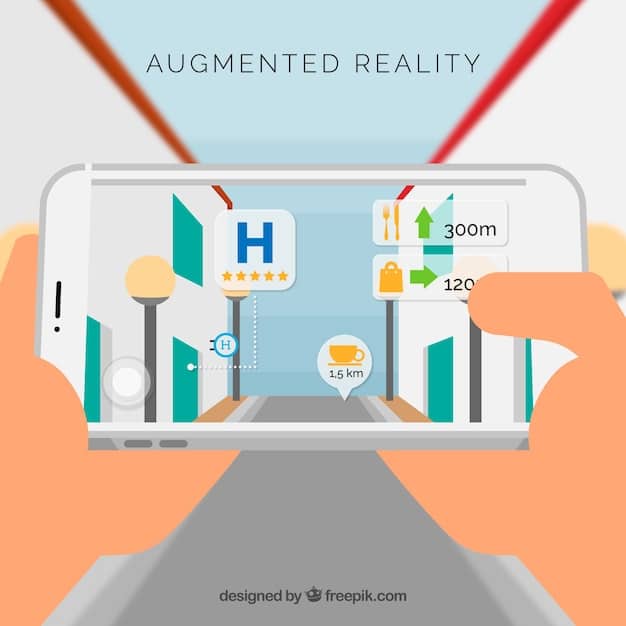Mobile Marketing: Optimize Your Website & Campaigns

Mobile marketing is essential for modern businesses, leveraging mobile devices to engage audiences through website optimization, compelling campaigns, and data-driven personalization to achieve superior conversion rates and brand loyalty.
In today’s digital landscape, where smartphones are extensions of ourselves, Mobile Marketing: Optimizing Your Website and Campaigns for Mobile Devices is no longer just an option but a critical imperative. Understanding how to connect with your audience on their preferred devices offers a powerful pathway to engagement and conversion. This guide delves into the strategies and tactics necessary to thrive in the mobile-first world, ensuring your digital efforts resonate effectively.
The Indispensable Role of Mobile in Modern Marketing
Mobile devices have fundamentally reshaped consumer behavior, transforming how individuals access information, interact with brands, and make purchasing decisions. This paradigm shift means businesses must prioritize mobile experiences, not merely as an afterthought, but as the cornerstone of their digital marketing strategy. Failing to adapt to this mobile-centric reality risks alienating a significant portion of potential customers and ceding competitive advantage.
The ubiquity of smartphones dictates that a mobile-first approach is now the standard, impacting everything from website design to content creation and advertising. Consumers expect seamless, fast, and intuitive experiences regardless of the device they use. This expectation places a considerable burden on marketers to deliver consistently high-quality interactions across all mobile touchpoints. Ignoring these expectations can lead to high bounce rates, low engagement, and ultimately, lost revenue. The focus must be on creating an environment where mobile users feel valued and their journey is as frictionless as possible.
Mobile Usage Statistics and Consumer Behavior
Understanding current mobile usage statistics is crucial for illustrating the urgency and scope of mobile optimization. Recent data consistently shows that a majority of internet traffic and digital content consumption now occurs on mobile devices. For instance, studies indicate that over 50% of global website traffic originates from mobile phones, a figure that continues to grow year over year. This trend is not confined to specific demographics; rather, it reflects a broad societal shift towards mobile convenience.
* In 2024, mobile devices accounted for over 60% of all online retail traffic.
* The average American spends over 4 hours daily on their smartphone.
* Mobile ad spending is projected to exceed desktop ad spending by a significant margin.
These statistics underscore a fundamental truth: if your audience is primarily on mobile, your marketing efforts must meet them there. Consumer behavior on mobile is also distinct. Users often seek quick information, immediate solutions, and streamlined processes. This demands a different approach to content, calls-to-action, and overall user experience compared to desktop environments. Building trust and delivering immediate value on mobile are paramount.
The shift towards mobile has also spurred innovations in various marketing channels. From SMS to in-app advertising, mobile provides a diverse ecosystem for reaching and engaging consumers. Successful mobile marketing strategies integrate these diverse channels into a cohesive and personalized customer journey. For businesses, this means understanding the nuances of how their target audience interacts with different mobile platforms and tailoring their messaging accordingly. This detailed understanding allows for more effective resource allocation and higher returns on mobile marketing investments.
Website Optimization for Mobile Responsiveness
Optimizing your website for mobile devices is foundational to any successful mobile marketing strategy. A responsive design ensures that your site adapts seamlessly to any screen size, offering an optimal viewing and interaction experience for all users. This is not merely an aesthetic choice; it significantly impacts user engagement, search engine rankings, and ultimately, conversion rates. Google, for instance, heavily favors mobile-friendly websites in its search results, making responsiveness a direct factor in your organic visibility.
The goal of mobile optimization extends beyond just visual adaptability. It encompasses factors like loading speed, intuitive navigation, and touch-friendly elements. Mobile users are notoriously impatient; a slow-loading site or one difficult to navigate can cause them to abandon it quickly. Therefore, every aspect of your website must be designed with the mobile user in mind, providing a fluid and efficient journey from discovery to conversion.
Implementing Responsive Web Design
Responsive web design (RWD) is the cornerstone of mobile website optimization. RWD uses flexible layouts, images, and cascading style sheet (CSS) media queries to adapt the website’s appearance to various screen sizes. This “single site, multiple devices” approach simplifies maintenance and ensures consistency across platforms. The primary benefit is that you don’t need separate websites for desktop and mobile, streamlining your content management.
While implementing RWD, several key considerations come into play. Prioritizing content is essential; what matters most on mobile should be immediately visible and accessible. Large, clunky images and excessive text can hinder mobile performance, so optimization of media files and conciseness of copy are critical. The user interface elements, such as buttons and links, must be appropriately sized and spaced for touch interaction, preventing accidental clicks and improving usability. Ensuring your calls-to-action are prominent and easy to engage with on mobile screens is vital for driving conversions.
Page Speed and Performance: Crucial for Mobile
Page speed is a critical determinant of mobile user experience and directly impacts SEO. Mobile users expect pages to load almost instantly. Research indicates that a delay of even a few seconds can significantly increase bounce rates and negatively affect conversion goals. Search engines also penalize slow-loading sites, pushing them lower in search results. Therefore, optimizing website performance for mobile is not just a best practice but a competitive necessity.
Techniques for improving mobile page speed include:
* Image Optimization: Compressing images and using modern formats like WebP can reduce file sizes without sacrificing quality. Lazy loading images also ensures that images only load when they are visible in the user’s viewport.
* Code Minification: Reducing the file size of HTML, CSS, and JavaScript files by removing unnecessary characters like whitespace and comments.
* Leveraging Browser Caching: Storing temporary data on the user’s device so that subsequent visits load faster.
* Reducing Server Response Time: Optimizing server configuration and using a high-quality hosting provider.
Regularly testing your website’s mobile performance using tools like Google PageSpeed Insights provides actionable insights into areas for improvement. Continuously monitoring and refining your site’s speed ensures that your mobile audience receives the fast, efficient experience they demand, leading to higher engagement and better outcomes for your mobile marketing efforts.
Crafting Effective Mobile Marketing Campaigns
Beyond website optimization, successful mobile marketing hinges on the strategic development and execution of campaigns tailored specifically for mobile consumption. This involves understanding the nuances of various mobile channels, crafting concise and compelling messages, and leveraging data to personalize experiences. Effective mobile campaigns don’t just reach users on their devices; they connect with them in a meaningful, timely, and contextually relevant way, fostering positive brand interactions and driving desired actions.
The fragmented nature of the mobile ecosystem demands a multifaceted approach. From SMS to in-app advertisements and social media, each channel offers unique opportunities and challenges. Businesses must select the most appropriate channels for their target audience and campaign objectives, ensuring their messages are optimized for each specific platform. The overarching goal is to deliver value directly to the user, making every interaction purposeful and beneficial.
SMS Marketing: Direct and Immediate Engagement
SMS marketing, while often perceived as traditional, remains one of the most direct and effective ways to engage mobile users. Its high open rates—often exceeding 90%—make it an invaluable tool for urgent communications, promotions, and customer service alerts. The immediacy of SMS ensures that messages are seen almost instantly, cutting through the noise of other digital channels.
Key strategies for successful SMS marketing include:
* Obtain Consent: Always ensure you have explicit opt-in from users before sending SMS messages to maintain trust and compliance.
* Keep Messages Concise: SMS has character limits, so messages must be clear, to the point, and contain a strong call-to-action.
* Offer Value: Provide exclusive deals, timely updates, or helpful information to make recipients feel valued and prevent opt-outs.
* Timing is Crucial: Send messages at optimal times when they are most likely to be well-received and acted upon.
SMS marketing is particularly powerful for local businesses, appointment reminders, flash sales, and customer loyalty programs. By integrating SMS with other marketing efforts, businesses can create a robust and interconnected mobile customer journey, ensuring they stay top of mind and drive immediate responses.

In-App Advertising: Reaching Engaged Users
In-app advertising offers a unique opportunity to reach highly engaged users within their favorite mobile applications. Unlike mobile web browsing, users within apps are often more focused and receptive to specific content, making in-app ads a powerful tool for brand awareness, user acquisition, and driving conversions. This advertising method comes in various forms, including banner ads, interstitial ads (full-screen pop-ups), rewarded video ads, and native ads that blend seamlessly with the app’s content.
The effectiveness of in-app advertising stems from its ability to leverage app usage data for precise targeting. Advertisers can segment audiences based on app categories, user demographics, behaviors, and even real-time location. This granular targeting ensures that ads are displayed to the most relevant users, maximizing campaign efficiency and return on ad spend. Moreover, many in-app ad formats, such as rewarded videos, offer a positive user experience by providing value (e.g., in-app currency or content) in exchange for engagement.
To maximize the impact of in-app campaigns, consider:
* User Experience: Ensure ads are non-intrusive and provide value, rather than disrupting the user’s flow.
* Contextual Relevance: Align your ad content with the app’s theme or user’s in-app behavior.
* Clear Calls to Action: Make it easy for users to understand what action you want them to take.
By carefully planning and executing in-app advertising, businesses can tap into a highly receptive audience, driving app installs, increasing brand visibility, and accelerating conversions within the mobile ecosystem. It is an evolving space that requires continuous testing and optimization to yield the best results.
Personalization and Data-Driven Mobile Strategies
In the realm of mobile marketing, personalization moves beyond a mere trendy concept to become an absolute necessity for meaningful engagement. Mobile devices are inherently personal, used in intimate settings, making a generic, one-size-fits-all approach feel out of place and intrusive. Data-driven personalization allows businesses to tailor experiences, messages, and offers to individual users based on their behaviors, preferences, and context, significantly enhancing relevance and driving better outcomes.
The wealth of data available from mobile interactions – from location to app usage and browsing history – provides unprecedented opportunities for creating highly customized marketing efforts. Leveraging this data responsibly and ethically is key to building trust and fostering long-term customer relationships. When executed correctly, personalization transforms marketing from a broadcast medium into a dialogue, making users feel understood and valued.
Leveraging Mobile Data for Personalization
The power of personalization in mobile marketing lies in its ability to harness vast amounts of user data. This data can include demographic information, geographic location, browsing history, purchase history, app usage patterns, and even real-time contextual signals like weather or time of day. When analyzed effectively, this data paints a comprehensive picture of user preferences and needs, enabling marketers to deliver precisely what the user wants, when and where they need it.
For instance, location-based data allows for geo-fencing campaigns that send relevant offers when a user is near a physical store. Behavioral data collected from app usage can power push notifications with personalized product recommendations. The key is to integrate data from various sources (CRM, website analytics, mobile app analytics) into a unified customer profile, providing a holistic view that fuels richer personalization.
However, the collection and use of mobile data come with significant responsibilities regarding privacy. Businesses must be transparent about their data practices, comply with regulations like GDPR and CCPA, and always prioritize user trust. Ethical data handling is not just a compliance issue; it’s a critical component of building a brand that resonates positively with today’s privacy-conscious consumers.
Implementing A/B Testing and Analytics
To truly optimize mobile marketing efforts, ongoing A/B testing and meticulous analytics are indispensable. A/B testing allows marketers to compare two versions of an ad, landing page, or message to determine which performs better in terms of engagement, clicks, or conversions. This systematic approach eliminates guesswork, ensuring decisions are based on empirical evidence rather than assumptions.
Key elements for effective A/B testing include:
* Single Variable Testing: Only change one element at a time (e.g., headline, call-to-action, image) to isolate the impact of that specific change.
* Sufficient Sample Size: Ensure enough traffic goes to each version to yield statistically significant results.
* Clear Goals: Define what success looks like for each test (e.g., higher click-through rate, lower bounce rate).
Complementing A/B testing, robust mobile analytics tools provide deep insights into user behavior. These tools track metrics such as app downloads, active users, session duration, key conversion funnels, and retention rates. By regularly reviewing these metrics, marketers can identify bottlenecks, understand user journeys, and pinpoint areas for improvement. For example, if analytics reveal a high drop-off rate on a specific page, A/B testing can then be used to optimize that page’s design or content.
Together, A/B testing and analytics form a continuous feedback loop, enabling marketers to iterate and refine their mobile strategies. This data-driven approach ensures that campaigns are not only effective in the short term but also continuously optimized for long-term success and changing mobile landscapes. It embodies the agile nature required for thriving in the dynamic world of mobile marketing.
Mobile Video and Rich Media Content
The immersive nature of mobile devices makes them ideal platforms for engaging content formats, particularly video and rich media. In an environment where attention spans are fleeting, well-produced video content can capture and retain user interest more effectively than static text or images. Rich media, encompassing interactive elements, animations, and dynamic ads, further enhances the mobile experience, making it more engaging and memorable. Businesses are increasingly investing in these formats to stand out in crowded digital spaces.
The power of video on mobile stems from its ability to convey complex messages quickly and emotionally. From short social media clips to in-depth product demonstrations, video offers a versatile medium for storytelling. Rich media, on the other hand, allows for active user participation, transforming passive consumption into an interactive experience. Both are crucial for capturing the dynamic behavior of mobile users and delivering impactful marketing messages that resonate deeply.
Optimizing Video for Mobile Consumption
Creating video content is one thing; optimizing it for mobile consumption is another entirely. Mobile users often consume video on the go, with varying network speeds, and often in portrait orientation. Therefore, specific considerations are necessary to ensure your video content performs optimally and provides a seamless viewing experience on mobile devices.
Key optimization strategies for mobile video include:
* Short and Engaging: Mobile videos should ideally be concise, with the most crucial information delivered in the first few seconds to quickly hook the viewer. Many platforms enforce time limits, further emphasizing brevity.
* Vertical Video Formats: With most smartphone use occurring in portrait mode, designing videos with a 9:16 aspect ratio (vertical video) can provide a fullscreen, immersive experience without requiring the user to rotate their device.
* Captions and Subtitles: A significant portion of mobile video is watched with the sound off. Including captions or subtitles ensures your message is accessible and understood even in noisy environments or when users prefer silent viewing.
* Compression and Loading Speed: Optimize video file sizes to balance quality and load times. Slow-loading videos lead to frustration and abandonment. Utilize responsive video players that adapt to network conditions.
By focusing on these elements, businesses can create mobile video content that is not only visually appealing but also technically optimized for the unique constraints and preferences of mobile users, leading to higher engagement rates and better campaign performance.
Interactive and Dynamic Rich Media Ads
Rich media ads transcend traditional static banners by incorporating interactive elements such as animation, video, games, and forms directly within the ad unit. On mobile, these dynamic ads offer a powerful way to capture user attention and encourage deeper engagement. Instead of passively viewing, users can tap, swipe, and interact, creating a more memorable and effective brand experience.
Examples of interactive rich media include:
* Expandable Ads: Ads that expand to fill the screen or reveal more content upon user interaction.
* Playable Ads: Mini-games or demos that allow users to experience a product or feature before downloading an app or visiting a website.
* 360-Degree Views: Interactive carousels or product viewers that allow users to explore items from all angles.
* Polls and Quizzes: Engaging formats that encourage user participation and data collection.
The benefits of rich media ads are significant: they often boast higher click-through rates and conversion rates compared to standard ads due to their immersive and engaging nature. They also provide valuable data on user interaction, offering insights into what truly resonates with the audience. Developing rich media requires specialized tools and expertise, but the increased engagement and ROI often justify the investment, making them a cornerstone of advanced mobile marketing campaigns.
Measuring Mobile Marketing Success
Measurement is fundamental to any marketing endeavor, and mobile marketing is no exception. Without robust analytics and clear key performance indicators (KPIs), it’s impossible to understand what’s working, what’s not, and where to allocate resources most effectively. Measuring mobile marketing success extends beyond simple clicks or impressions; it involves a deeper dive into user behavior, journey analysis, and ultimately, the impact on business objectives. A data-driven approach ensures continuous optimization and maximizes the return on investment for your mobile strategies.
The fragmented nature of mobile, with its various channels and devices, necessitates a comprehensive tracking strategy. This requires integrating data from multiple sources – website analytics, app analytics, campaign platforms, and CRM systems – into a unified view. Only then can marketers gain a holistic understanding of how mobile efforts contribute to overall business goals.
Key Performance Indicators (KPIs) for Mobile
Defining and tracking relevant KPIs is crucial for evaluating the effectiveness of your mobile marketing campaigns. These indicators provide clear metrics to gauge progress towards specific goals and inform future strategic decisions. KPIs should align with your broader marketing and business objectives, from brand awareness to direct conversions.
Common mobile marketing KPIs include:
* Mobile Traffic: The number of users accessing your website or app from mobile devices.
* Mobile Conversion Rate: The percentage of mobile visitors who complete a desired action (e.g., purchase, sign-up, download).
* Page Load Speed (Mobile): Crucial for user experience; directly impacts bounce rates.
* Mobile Bounce Rate: The percentage of mobile users who leave your site after viewing only one page. A high bounce rate indicates potential usability issues.
* App Downloads/Installs: For app-centric businesses, tracks initial user acquisition.
* App Engagement Metrics: Daily/monthly active users (DAU/MAU), session duration, and feature usage.
* Customer Lifetime Value (CLTV): The total revenue expected from a customer over their relationship with your brand, especially relevant for ongoing mobile engagement.
* Mobile Ad Click-Through Rate (CTR): The percentage of times your mobile ads are clicked compared to views.
Regularly monitoring these KPIs helps identify trends, spot opportunities, and diagnose issues. For instance, a high mobile bounce rate combined with low page speed indicates a clear need for performance optimization. Conversely, an increasing mobile conversion rate signifies effective campaign targeting and website experience.
Attribution Models in Mobile Marketing
Understanding which touchpoints contributed to a conversion is essential for optimizing mobile marketing spending. Attribution models assign credit to different marketing channels that a customer interacted with before converting. In the mobile ecosystem, where user journeys can span multiple devices and channels (e.g., seeing an ad on mobile, then converting on desktop), sophisticated attribution is vital.
Common attribution models include:
* First-Click Attribution: Assigns all credit to the very first mobile touchpoint that brought the user into the funnel.
* Last-Click Attribution: Gives all credit to the last mobile touchpoint before conversion. While simple, it often understates the value of earlier interactions.
* Linear Attribution: Distributes credit equally among all mobile touchpoints in the conversion path.
* Time Decay Attribution: Assigns more credit to touchpoints closer in time to the conversion.
* Position-Based Attribution: Often gives significant credit to the first and last touchpoints, with remaining credit distributed among middle interactions.
The choice of attribution model impacts how you view the performance of your mobile campaigns and channels. There is no one-size-fits-all solution; the best model depends on your business goals and the complexity of your customer journey. Implementing a multi-touch attribution model, which considers all interactions leading to a conversion, generally provides a more accurate picture of how mobile marketing efforts contribute to revenue. This insight is critical for optimizing budget allocation and refining mobile strategies for maximum impact.
Future Trends in Mobile Marketing
The mobile marketing landscape is in constant flux, driven by rapid technological advancements and evolving consumer behaviors. Staying abreast of emerging trends is not just about adopting new tools; it’s about anticipating shifts in how consumers interact with brands and leveraging these insights to maintain a competitive edge. The future of mobile marketing promises even greater personalization, automation, and immersive experiences, pushing the boundaries of traditional engagement.
From the rise of augmented reality to the growing importance of privacy, these trends will shape how businesses connect with their mobile audiences. Adapting proactively to these shifts will be paramount for sustained success, requiring marketers to be agile, innovative, and deeply attuned to the pulse of mobile technology. The focus will increasingly be on creating seamless, value-driven interactions that feel intuitive and natural within the mobile environment.
Augmented Reality (AR) and Virtual Reality (VR)
Augmented Reality (AR) and Virtual Reality (VR) are poised to revolutionize mobile marketing by offering immersive and interactive brand experiences. While VR typically requires dedicated headsets, AR overlays digital information onto the real world using a smartphone camera, making it immediately accessible to a vast mobile audience. This technology allows consumers to “try on” products, visualize furniture in their homes, or interact with branded content in their immediate environment, blurring the lines between the physical and digital.
For instance, beauty brands use AR apps to let users virtually try on makeup, while furniture retailers enable customers to place virtual models of sofas in their living rooms. These experiences are not just novel; they provide significant utility, reduce purchase hesitation, and create memorable brand interactions. As AR capabilities become more sophisticated and integrated into popular apps and social media platforms, its potential for mobile marketing will only grow.
The Evolution of Voice Search and AI
The proliferation of voice assistants like Siri, Google Assistant, and Alexa has led to a significant increase in voice search, a trend with profound implications for mobile marketing. Voice search queries tend to be longer, more conversational, and often location-based, differing significantly from traditional text-based searches. Optimizing content for voice search involves focusing on natural language, answering specific questions, and providing immediate, concise answers, often framed as featured snippets.
Artificial Intelligence (AI) underpins much of the innovation in mobile marketing. AI powers sophisticated personalization engines that analyze user data to deliver highly relevant content and offers. It drives chatbots that provide instant customer service, improving user experience and efficiency. AI also optimizes ad targeting, predicts consumer behavior, and automates campaign management, freeing marketers to focus on strategy. As AI continues to evolve, its capacity to enhance mobile marketing will only expand, enabling hyper-personalized experiences at scale and driving unprecedented levels of efficiency and effectiveness.

| Key Mobile Marketing Focus | Brief Description |
|---|---|
| 📱 Mobile-First Website | Ensuring your website design prioritizes responsiveness and fast loading times for mobile users, crucial for SEO and user experience. |
| ✉️ Targeted Mobile Campaigns | Crafting specific campaigns for mobile channels like SMS and in-app ads, tailored for device-specific interactions. |
| 📊 Data-Driven Personalization | Utilizing mobile data to personalize content, offers, and user journeys, enhancing relevance and engagement. |
| 🔮 Adapting to Future Trends | Staying ahead with emerging technologies like AR/VR and optimizing for voice search and AI in mobile strategy. |
Frequently Asked Questions
▼
Mobile-first optimization is vital because most internet traffic and digital consumption now occur on mobile devices. Google also prioritizes mobile-friendly sites in its search rankings, directly impacting your visibility and organic traffic. A well-optimized mobile site ensures a positive user experience, reducing bounce rates and improving conversion potential by catering to users’ preferred method of access.
▼
The most effective mobile marketing channels include responsive websites, SMS marketing, in-app advertising, and social media marketing optimized for mobile. Each channel offers unique benefits; SMS provides direct, immediate engagement, while in-app ads reach highly targeted and engaged users. The best strategy often involves an integrated approach combining these channels to create a comprehensive customer journey.
▼
Personalization in mobile marketing involves leveraging user data such as location, browsing history, and purchase behavior to deliver relevant content and offers. Marketers can use AI-driven tools to segment audiences and tailor messages, creating a more engaging and effective experience. Examples include location-based promotions, personalized product recommendations via push notifications, and customized in-app experiences.
▼
Mobile video and rich media offer highly engaging and immersive experiences crucial for capturing attention on mobile devices. Videos convey messages quickly, while rich media ads provide interactive elements like games or 360-degree views, improving user engagement and retention. These formats are effective for storytelling, product demonstrations, and generating higher click-through rates due to their dynamic nature.
▼
Measuring mobile marketing success involves tracking key performance indicators (KPIs) like mobile traffic, conversion rates, page load speed, and app engagement metrics. Utilizing robust analytics tools and understanding attribution models are also essential to determine which channels contribute most to conversions. This data-driven approach allows for continuous optimization, ensuring your strategies effectively meet business objectives and deliver strong ROI.
Conclusion
The landscape of digital interaction has irrevocably shifted towards mobile, making Mobile Marketing: Optimizing Your Website and Campaigns for Mobile Devices a non-negotiable aspect of contemporary business strategy. From ensuring your website is seamlessly responsive to crafting highly personalized and data-driven campaigns, success in this domain hinges on a deep understanding of mobile user behavior and the strategic application of diverse technologies. By embracing responsive design, leveraging mobile-specific channels like SMS and in-app advertising, consistently personalizing user experiences, and staying ahead of immersive technologies like AR/VR, businesses can not only meet but exceed the expectations of their mobile-first audience. Continual measurement and adaptation are paramount, ensuring that mobile marketing efforts yield tangible results and contribute significantly to overall business growth.





